($32, Artisans Wines, Inc.): 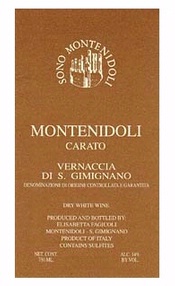 Carato, another Vernaccia di San Gimignano from the exemplary producer Montenidoli, is fermented and aged for a year in barrel before bottling. The winemaking here is so precise that you don’t taste woodiness. Rather, you feel the effect of wood on the wine — it’s a fuller, richer version of Vernaccia di San Gimignano that retains finesse and vigor. … Read more
Carato, another Vernaccia di San Gimignano from the exemplary producer Montenidoli, is fermented and aged for a year in barrel before bottling. The winemaking here is so precise that you don’t taste woodiness. Rather, you feel the effect of wood on the wine — it’s a fuller, richer version of Vernaccia di San Gimignano that retains finesse and vigor. … Read more
Category Archives: Reviews
Montenidoli, Vernaccia di San Gimignano (Tuscany, Italy) “Fiore” 2012
($25, Artisans Wines, Inc.): 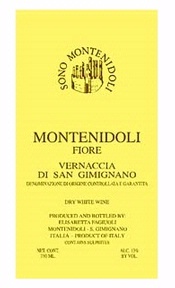 Montenidoli is one of the very best producers of Vernaccia di San Gimignano. Anyone who has been disappointed by this category of Italian white should taste their wines to see how grand this DOCG can be. Montenidoli makes three Vernaccia di San Gimignano; this one, made from free-run juice and labeled Fiore (flower) is, indeed, floral, fresh and clean. … Read more
Montenidoli is one of the very best producers of Vernaccia di San Gimignano. Anyone who has been disappointed by this category of Italian white should taste their wines to see how grand this DOCG can be. Montenidoli makes three Vernaccia di San Gimignano; this one, made from free-run juice and labeled Fiore (flower) is, indeed, floral, fresh and clean. … Read more
Montenidoli, Toscana Rosso IGT (Italy) “Sono Montenidoli” 2007
($55, Artisans Wines, Inc.): 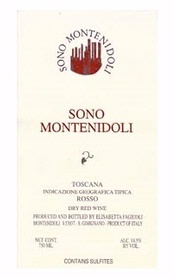 Since Montenidoli is one of the star producers of Vernaccia di San Gimignano, their red wines, such as this IGT Toscana, are often overlooked. That’s a mistake, since this one, labeled redundantly Sono Montenidoli for emphasis, is a sleeper of a Super Tuscan. … Read more
Since Montenidoli is one of the star producers of Vernaccia di San Gimignano, their red wines, such as this IGT Toscana, are often overlooked. That’s a mistake, since this one, labeled redundantly Sono Montenidoli for emphasis, is a sleeper of a Super Tuscan. … Read more
Badia a Coltibuono, Chianti Classico Riserva (Tuscany, Italy) 2010
($34, Dalla Terra Direct): Since the 2010 vintage was superb in Chianti Classico and Badia a Coltibuono is one of the star producers in that region, it is not surprising that this wine is stellar. Not boisterous, this is a classically proportioned Chianti Classico Riserva with great elegance and a seamless combination of bright red fruit flavors and earthy notes. … Read more
Badia a Coltibuono, Chianti Classico (Tuscany, Italy) 2012
($14, Dalla Terra Direct): This Chianti Classico reminds us that Badia a Coltibuono consistently makes attractive wines. The vintage was difficult in the Chianti Classico region because of less-than-perfect weather. Nonetheless, Badia a Coltibuono has fashioned a traditionally framed — that is, not overdone — Chianti Classico. … Read more
G. D. Vajra, Dolcetto d’Alba (Piedmont, Italy) “Coste e Fossati” 2013
($26): G. D. Vajra, one of my favorite Barolo producers, also makes excellent wines from other traditional Piedmont grapes, such as this Dolcetto. This is an unusual Dolcetto because the vines are over 100 years old and they are planted in a two vineyards — Coste and Fossati — that actually lie in the Barolo DOCG and could be planted with Nebbiolo and sold at a far higher price. … Read more
Mirafiore, Barolo (Piedmont, Italy) “Paiagallo” 2010
($80, Domaine Select Wine Estates): Here’s another example of the stature of the 2010 vintage in Barolo. Serralunga, the village within the Barolo DOCG zone where the Paiagallo vineyard is located, is known for powerful wines. Mirafiore’s certainly fits that description.… Read more
Damilano, Barolo (Piedmont, Italy) Cannubi 2010
($85): 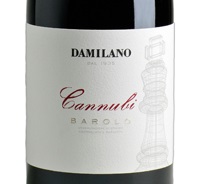 Cannubi is one of the truly great vineyards in the Barolo zone. If there were a Burgundy-like classification system of vineyards in Barolo, Cannubi would clearly be awarded the equivalent of Grand Cru status. Combine grapes from this vineyard, the stunning 2010 vintage, and an excellent producer and… bingo, you have a stellar wine. … Read more
Cannubi is one of the truly great vineyards in the Barolo zone. If there were a Burgundy-like classification system of vineyards in Barolo, Cannubi would clearly be awarded the equivalent of Grand Cru status. Combine grapes from this vineyard, the stunning 2010 vintage, and an excellent producer and… bingo, you have a stellar wine. … Read more
Damilano, Barbera d’Asti (Piedmont, Italy) 2013
($17): I admit it. I love good Barbera. Along with Dolcetto, another workhorse grape and wine from Piedmont, Barbera is often my go-to choice at Italian restaurants because it meshes so nicely with food and almost always offers good value. Damilano (an estate that also made excellent Barolo in 2010) made a 2013 Barbera d’Asti that’s easy to embrace. … Read more
Viña Carmen, Colchagua Valley (Rapel Valley, Chile) Carmenere Gran Reserva 2011
($15, Trinchero): 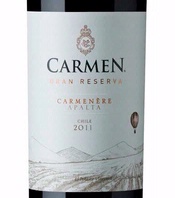 Is it just a coincidence that a producer named Carmen should excel with Carmenere, which is arguably Chile’s national grape? Coincidence or not, they’ve excelled with this 2011. The Apalta area, one of the most famous ones in the Colchagua Valley, supplied the raw materials and the winemaking team at Viña Carmen turned them into excellent wine. … Read more
Is it just a coincidence that a producer named Carmen should excel with Carmenere, which is arguably Chile’s national grape? Coincidence or not, they’ve excelled with this 2011. The Apalta area, one of the most famous ones in the Colchagua Valley, supplied the raw materials and the winemaking team at Viña Carmen turned them into excellent wine. … Read more
Marques de Caceres, Rioja (Spain) Blanco 2009
($9, Vineyard Brands): To most consumers, Rioja means red. And to be fair, the vast amount of it is. Until the last decade or so, the white wine produced in Rioja was not popularity here because it was often oxidized and tired. … Read more
Sartori, Amarone della Valpolicella Classico (Veneto, Italy) Corte Brà 2008
($55, Banfi): This is a beautifully balanced young Amarone showing the potential of this great DOCG. Not particularly tannic, but youthful because of its tightly wound structure, a hint of its grandeur still peeks out. This is a serious Amarone with an enticing bitterness in the finish. … Read more
Tascante, Sicilia IGT (Italy) “Ghiaia Nera” 2012
($22, Dalla Terra Direct):  Tascante is the name of the Mount Etna project of Tasca d’Almerita, one of the locomotives that have brought Sicilian wines to the world’s attention. (The name is an amalgamation of Tasca appended to Etna, spelled backwards.) … Read more
Tascante is the name of the Mount Etna project of Tasca d’Almerita, one of the locomotives that have brought Sicilian wines to the world’s attention. (The name is an amalgamation of Tasca appended to Etna, spelled backwards.) … Read more
Agricole Vallone, Salice Salentino Riserva (Puglia, Italy) “Vereto” 2008
($15, Quintessential Wines): Puglia, the “heel” of Italy’s “boot,” is home to some amazing and well-priced wines. This one, and Vallone’s Vigna Flamino, are two that should not be missed because they offer incredible enjoyment at an affordable price. The Salice Salentino Riserva, made entirely from Negroamaro, is a hefty wine, but not overdone, with an alluring subtle bitterness in the finish. … Read more
Agricole Vallone, Brindisi Riserva (Puglia, Italy) Vigna Flaminio 2008
($15, Quintessential Wines): Similar to Vallone’s Salice Salentino Riserva, this wine is also a wonderfully expressive gem from Puglia. A blend of Negroamaro (80%) and Montepulciano, it’s slightly less dense and a touch brighter and more energetic than its stable mate. … Read more
Elvio Cogno, Nascetta di Novello Langhe (Piedmont, Italy) Novello “Anas-Cëtta” 2013
($28, Wilson Daniels): It takes a bit of work to sort out the label, but it’s worth it. Starting at the top, Elvio Cogno is a red-hot producer in Piedmont best known for their Barolo and Barbaresco. Nascetta is an obscure variety from the Langhe thought by some to be related to Vermentino, which they’ve had in their Novello vineyard for a couple of decades. … Read more
Damilano, Barolo (Piedmont, Italy) “Lecinquevigne” 2010
($35): Rarely have I read as much unanimity regarding the stature of a vintage as I have concerning the 2010 Barolo. And now, having tasted a fair number of them myself, I agree — it’s a consistently great vintage. Damilano is a well-known producer who bottles several single vineyard Barolos, which are captivating in 2010. … Read more
M. Chapoutier, Luberon (Rhône Valley, France) “La Ciboise” 2013
($15, Terlato Wines International): Though technically part of the Rhône, the Luberon is cool because of its elevation, with the harvest a couple of weeks later than Châteauneuf du Pape. The cooler climate likely explains the bright profile of this zippy wine. … Read more
René Bouvier, Marsannay (Burgundy, France) Les Longeroies Vieilles Vignes 2012
($31, Kermit Lynch): Marsannay, sitting at the northern most boundary of the Côte d’Or, is another great appellation for authentic, well-priced Burgundy. Since Marsannay is not a prestigious appellation, many of its red wines are ready to drink soon after release. … Read more
Domaine Charles Audoin, Marsannay (Burgundy, France) Les Longeroies 2011
($36, Martine’s Wines): Marsannay received appellation status only in 1987. Prior to that date, the wines were sold under the broader Bourgogne appellation. Growers in Marsannay have submitted an application to the French authorities to classify some vineyards as Premier Cru. … Read more
Domaine Bertagna, Hautes Côtes de Nuits (Burgundy, France) “Les Dames Huguettes” 2012
($29): One way to find well-priced Burgundy (no, that’s not an oxymoron) is to choose a down-market appellation from a top-notch producer, such as Domaine Bertagna. Although Les Dames Huguettes lies in the appellation of Hautes Côtes de Nuits, just west (up and behind) the escarpment of the Côte d’Or, the vineyard itself still lies within the boundaries of the village of Nuits St Georges. … Read more
Mercer Estates, Yakima Valley (Washington) Sauvignon Blanc 2013
($14): This is another pleasant surprise from the category of under $14 a bottle Sauvignon Blanc tasted blind at this year’s San Francisco Chronicle Wine Competition. Nicely pungent, it delivers a nice bite without going overboard. It has a remarkable finish, especially at this price.… Read more
Steelhead Vineyards, North Coast (California) Sauvignon Blanc 2013
($13): One of the great things I love about judging at wine competitions is the opportunity to taste wines blind that I might not otherwise run across. And often, the surprises are extremely pleasant, as in this case, with a wine in the under $14 category of Sauvignon Blanc at the San Francisco Chronicle Wine Competition. … Read more
Wild Oats, Edna Valley (Central Coast, California) Pinot Noir 2013
($15): Robert Oatley, the iconic Australian winemaker who founded the famous and widely popular Hunter Valley-based Rosemount Estate wine company, is the man behind Wild Oats. Using purchased fruit — as he did for years at Rosemount — his team has produced a value-packed California Pinot Noir.… Read more
Bellingham Estate, Western Cape (South Africa) Chenin Blanc Old Vine “The Bernard Series” 2013
($20): South Africa is home to some of the best Chenin Blanc in the world. Indeed, aside from the Loire Valley, I can think of nowhere that produces such high quality Chenin Blanc so consistently. It should be that country’s signature white grape. … Read more
Giesen, Marlborough (New Zealand) Sauvignon Blanc 2014
($14): Sauvignon Blanc from the Marlborough region of New Zealand now enjoy a world wide reputation for quality and for the palate electrifying zing they deliver. What’s unusual is to find one with those qualities at this price. Giesen’s 2014 has an alluring lime-like citrus character that gives it Marlborough’s hallmark cutting edginess, while not screaming or assaulting the palate. … Read more
Cantina Mesa, IGT Isola dei Nuraghi (Italy) “Buio Buio” 2010
($20, Montcalm Wine Importers): Made from the Carignano del Sulcis grape, the local name for Carignan grown in the Sulcis region of southwestern Sardinia, Buio Buio is a name to remember. For a vigorous and robust red, it has surprising finesse. … Read more
Maison Louis Latour, Montagny Premier Cru (Burgundy, France) “La Grande Roche” 2012
($25, Louis Latour USA): Montagny is an often-overlooked village in the Côte Chalonnaise that is home to some excellent white Burgundies, such as this one. Latour has combined the ripeness of the vintage with a steely backbone that keeps it fresh and lively throughout a meal. … Read more
Maison Louis Jadot, Bourgogne Blanc (Burgundy, France) Chardonnay 2013
($16, Kobrand Wine And Spirits):
It’s no surprise that Louis Jadot, one of Burgundy’s top producers, makes a fine “simple” Bourgogne Blanc. A blend of Chardonnay grown in the Côte d’Or, the Côte Chalonnaise and the Macon, it’s not so simple and is a great value.… Read more
Maison Louis Latour, Marsannay (Burgundy, France) 2012
($24, Louis Latour USA):  Marsannay, now practically a suburb of Dijon, is the northern most outpost of the Côte de Nuits. With no classified vineyards — but deserving of some — the village offers the best value for red wines from the entire Côte d’Or, in my opinion. … Read more
Marsannay, now practically a suburb of Dijon, is the northern most outpost of the Côte de Nuits. With no classified vineyards — but deserving of some — the village offers the best value for red wines from the entire Côte d’Or, in my opinion. … Read more
Maison Louis Latour, IGP Ardèche (France) Chardonnay “Grand Ardèche” 2012
($15, Louis Latour USA):  Maison Louis Latour, a top-notch Burgundy négociant founded over 200 years ago, branched out into the Ardèche, a sleepy area of central France, 25 years ago to have a go with Chardonnay there. It was their first venture outside of Burgundy and continues to be a resounding success because of the outstanding value of the wines they produce there. … Read more
Maison Louis Latour, a top-notch Burgundy négociant founded over 200 years ago, branched out into the Ardèche, a sleepy area of central France, 25 years ago to have a go with Chardonnay there. It was their first venture outside of Burgundy and continues to be a resounding success because of the outstanding value of the wines they produce there. … Read more
Merry Edwards, Sonoma Coast (California) Pinot Noir 2012
($39): With a forty year history of working with Pinot Noir, it’s no surprise that Merry Edwards is one of California’s star producers of that varietal. While her single vineyard bottlings show the diversity of sites, this one from the Sonoma Coast is a great introduction to her engaging style. … Read more
Merry Edwards, Russian River Valley (Sonoma County, California) Pinot Noir Coopersmith Vineyard 2012
($60): Merry Edwards and her husband, Ken Coopersmith, own this vineyard. Though the glossy texture is similar to the Georganne bottling, the darker, riper and denser flavors distinguish Coopersmith from the rest of her single vineyard Pinot Noir. It’s a bigger, but no less elegant, wine. … Read more
Merry Edwards, Russian River Valley (Sonoma County, California) Pinot Noir Georganne Vineyard 2012
($57): One of the reasons I admire Merry Edwards is because she makes Pinot Noir that reflect their origins — she is not trying to make red Burgundy. To be sure, she understands the subtlety and delicacy of Pinot Noir but also knows that grape expresses itself differently in the Russian River Valley than in the Côte d’Or. … Read more
Merry Edwards, Russian River Valley (Sonoma County, California) Pinot Noir Olivet Lane Vineyard 2012
($62):  Though similarly plush and polished, a thread of red fruit flavors is woven into the fabric of the Merry Edwards Olivet Lane Pinot Noir, which sets it apart from both the Coopersmith and Georganne bottlings. At this stage, with its charming subtleties, the Olivet Lane is the most expressive of her these three single vineyard bottlings. … Read more
Though similarly plush and polished, a thread of red fruit flavors is woven into the fabric of the Merry Edwards Olivet Lane Pinot Noir, which sets it apart from both the Coopersmith and Georganne bottlings. At this stage, with its charming subtleties, the Olivet Lane is the most expressive of her these three single vineyard bottlings. … Read more
Bodegas Bilbainas, Rioja Reserva (Spain) “Viña Pomal” 2010
($21): Befitting a Rioja Reserva, there’s healthy dose of savory non fruit flavors that adds complexity and balances the red and black fruitiness of this Tempranillo-based wine. Indeed, it’s the earthy quality in this mid-weight traditionally framed wine that is captivating. … Read more
Bodega la Bastida, Rioja (Spain) “R & G” 2010
($26, Kysela Père et Fils):  Though the producer is Bodega la Bastida, make no mistake, the names to remember are Michel Rolland, the internationally renowned oenologist who advising leading Bordeaux estates, and Javier Galarreta, a Spanish wine entrepreneur — hence the “R & G” emblazoned across the label. … Read more
Though the producer is Bodega la Bastida, make no mistake, the names to remember are Michel Rolland, the internationally renowned oenologist who advising leading Bordeaux estates, and Javier Galarreta, a Spanish wine entrepreneur — hence the “R & G” emblazoned across the label. … Read more
Bodegas Valtravieso, Ribera del Duero (Spain) “R & G” 2010
($26, Kysela Père et Fils):  A blend of mostly (90%) Tempranillo and Merlot, this, like their Rioja, is a joint venture between the world-famous enologist, Michel Rolland, a Spanish wine entrepreneur, Javier Galarreta, and Bodegas Valtravieso, from whose 200 acres Rolland selected the grapes. … Read more
A blend of mostly (90%) Tempranillo and Merlot, this, like their Rioja, is a joint venture between the world-famous enologist, Michel Rolland, a Spanish wine entrepreneur, Javier Galarreta, and Bodegas Valtravieso, from whose 200 acres Rolland selected the grapes. … Read more
G. D. Vajra, Barbera d’Alba (Piedmont, Italy) 2011
($23, The Country Vintner):  Vajra is a top Barolo producer, so when I spied their Barbera on a list at East 12th Osteria, an excellent, but under-the-radar restaurant with a thoughtful wine list in New York City, it was an obvious choice. … Read more
Vajra is a top Barolo producer, so when I spied their Barbera on a list at East 12th Osteria, an excellent, but under-the-radar restaurant with a thoughtful wine list in New York City, it was an obvious choice. … Read more
Domaine Marc Morey, Rully (Burgundy, France) 2012
($25, Robert Katcher Selections):  This wine caught my attention at Island Creek Oyster Bar (an excellent Boston restaurant with an eclectic wine list) because I was unaware that Marc Morey, a top producer based in Chassagne-Montrachet, owned vineyards in Rully (a lesser known village in the Côte Chalonnaise). … Read more
This wine caught my attention at Island Creek Oyster Bar (an excellent Boston restaurant with an eclectic wine list) because I was unaware that Marc Morey, a top producer based in Chassagne-Montrachet, owned vineyards in Rully (a lesser known village in the Côte Chalonnaise). … Read more
Concha y Toro, Puente Alto (Maipo Valley, Chile) Cabernet Sauvignon “Don Melchor” 2010
($125, Excelsior Wine and Spirits):  Don Melchor is the flagship wine of Concha y Toro, one of Chile’s leading producers. It is always ones of Chile’s best wines. And the 2010 is no exception — it is simply stunning and all the more so as it sits in the glass. … Read more
Don Melchor is the flagship wine of Concha y Toro, one of Chile’s leading producers. It is always ones of Chile’s best wines. And the 2010 is no exception — it is simply stunning and all the more so as it sits in the glass. … Read more
Truchard Vineyards, Carneros (Napa Valley, California) Chardonnay 2013
($30): Tony Truchard and his wife Jo Ann were early advocates of the virtues of the Carneros region of Napa Valley when they started to acquire their now 400 acres in the 1960s. It turns out the cool climate of Carneros is ideal for their Chardonnay, a consistently balanced wine. … Read more
Paul Cluver, Elgin (South Africa) Sauvignon Blanc 2012
($14, Carolina Wine Company):  Paul Cluver, a family owned and run vineyard and winery, lies about 40 miles southeast of Cape Town in the cool Elgin Valley. They specialize in varietals that thrive in cooler climates, such as this Sauvignon Blanc, which has a seamless mixture of fruit and pungency. … Read more
Paul Cluver, a family owned and run vineyard and winery, lies about 40 miles southeast of Cape Town in the cool Elgin Valley. They specialize in varietals that thrive in cooler climates, such as this Sauvignon Blanc, which has a seamless mixture of fruit and pungency. … Read more
Paul Cluver, Elgin (South Africa) Riesling 2012
($22, Carolina Wine Company):  The location of Paul Cluver winery in the cool Elgin Valley southeast of Cape Town explains why they excel with Riesling, a variety that thrives in cooler climes. This dry one has a touch of minerality to accompany the bracing lime-like acidity. … Read more
The location of Paul Cluver winery in the cool Elgin Valley southeast of Cape Town explains why they excel with Riesling, a variety that thrives in cooler climes. This dry one has a touch of minerality to accompany the bracing lime-like acidity. … Read more
Domaine de la Citadelle, Luberon (Rhône Valley, France) “Gouverneur Saint-Auban” 2013
($25): Domaine de la Citadelle, one of the top producers in the Luberon and a name to remember, makes a range of wines. This wine, labeled Gouverneur Saint-Auban, is their top white (They also make a stunning red under the same moniker). … Read more
Domaine de la Citadelle, Luberon (Rhône Valley, France) “Le Châtaignier” 2013
($17): Though the Luberon is known mostly for its red wines, notable whites are popping up in that appellation. This one, from one of the region’s top producers, is a blend of mostly (70%) Clairette and Grenache Blanc. Domaine de la Citadelle has avoided heaviness, something that plagues many Rhône whites, in this wine. … Read more
Domaine de la Citadelle, IGP Vaucluse (Rhône Valley, France) “Viognier de la Citadelle” 2013
($17): The regulations for the AOP (formerly known as AOC) Luberon require the wines be made from a blend of grapes because it’s the tradition in the region. That’s why this one, made entirely from Viognier, a white grape whose home is the northern Rhône, but thrives at Domaine de la Citadelle, carries the IGP designation instead of a more prestigious AOP. … Read more
Domaine de la Citadelle, Luberon (Rhône Valley, France) “Les Artemes” 2013
($22): This wine has, not surprisingly given the blend of Grenache and Syrah, considerable muscle for a rosé. A touch of structure and spice balances the density perfectly. Alexis Rousset-Rouard, who runs the domaine, puts it nicely, “It’s a rosé for September instead of May.” … Read more
Chateau la Canorgue, Luberon (Rhône Valley, France) 2011
($17, Polaner Selections):  Though located in the southern Rhône — but really in the heart of Provence — the Luberon is cooler than one would imagine because of its elevation. That explains why Syrah, a variety found more in the northern Rhone, is such an important component of the blends. … Read more
Though located in the southern Rhône — but really in the heart of Provence — the Luberon is cooler than one would imagine because of its elevation. That explains why Syrah, a variety found more in the northern Rhone, is such an important component of the blends. … Read more
Villa Ponciago, Fleurie (Beaujolais, France) La Réserve 2009
($20, Henriot, Inc):  Fleurie, similar to the other nine named villages or cru of the Beaujolais region, carries its own appellation. Indeed, there’s no reference to Beaujolais on Villa Ponciago’s label. And that’s probably just as well because this wine is as far away from the typical, slightly pejorative, image of Beaujolais. … Read more
Fleurie, similar to the other nine named villages or cru of the Beaujolais region, carries its own appellation. Indeed, there’s no reference to Beaujolais on Villa Ponciago’s label. And that’s probably just as well because this wine is as far away from the typical, slightly pejorative, image of Beaujolais. … Read more
